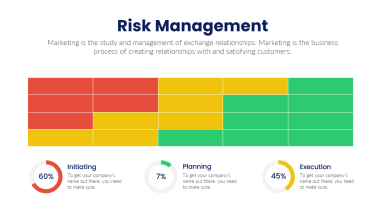
Originally published: 30/10/2023 09:53
Publication number: ELQ-61513-1
View all versions & Certificate
Publication number: ELQ-61513-1
View all versions & Certificate

Risk Management
Risk management is a systematic process of identifying, assessing, prioritizing, and mitigating potential risks and uncertainties.
Description
Here are key steps and components of a risk management process:
Risk Identification:
Identify and document all potential risks, including internal and external factors, that could impact the organization. Risks can be financial, operational, strategic, compliance-related, or related to external events (e.g., natural disasters).
Risk Assessment:
Evaluate the identified risks in terms of their likelihood of occurring and the potential impact on the organization. This assessment helps prioritize risks based on their significance.
Risk Analysis:
Analyze the nature and characteristics of each risk, including their root causes, potential consequences, and potential interdependencies with other risks.
Risk Mitigation and Control:
Develop strategies and actions to mitigate, control, or reduce the impact of identified risks. This may involve risk avoidance, risk reduction, risk sharing, or risk acceptance.
Risk Monitoring and Reporting:
Continuously monitor the risk landscape, track the effectiveness of risk mitigation strategies, and report on risk status to stakeholders. Regular reporting ensures that risks are managed effectively and transparently.
Risk Response Planning:
Develop detailed response plans for specific risks, including the steps to be taken if a risk materializes.
Crisis Management and Business Continuity Planning:
Prepare for worst-case scenarios by having crisis management and business continuity plans in place to ensure the organization can continue to operate in adverse conditions.
Compliance and Legal Risk Management:
Ensure that the organization complies with all relevant laws and regulations, and establish risk management practices that prevent legal issues.
Insurance and Risk Transfer:
Assess the need for insurance and other risk transfer mechanisms to reduce financial exposure to certain risks.
Risk Culture and Training:
Foster a risk-aware culture within the organization and provide training to employees to enhance their understanding of risk management.
Continuous Improvement:
Regularly review and update the risk management process to adapt to changing circumstances and emerging risks.
Effective risk management is essential for businesses to protect their assets, reputation, and financial stability. It also helps organizations make informed decisions and seize opportunities. It is a dynamic and ongoing process that requires commitment and vigilance from all levels of an organization, from leadership to front-line employees.
Here are key steps and components of a risk management process:
Risk Identification:
Identify and document all potential risks, including internal and external factors, that could impact the organization. Risks can be financial, operational, strategic, compliance-related, or related to external events (e.g., natural disasters).
Risk Assessment:
Evaluate the identified risks in terms of their likelihood of occurring and the potential impact on the organization. This assessment helps prioritize risks based on their significance.
Risk Analysis:
Analyze the nature and characteristics of each risk, including their root causes, potential consequences, and potential interdependencies with other risks.
Risk Mitigation and Control:
Develop strategies and actions to mitigate, control, or reduce the impact of identified risks. This may involve risk avoidance, risk reduction, risk sharing, or risk acceptance.
Risk Monitoring and Reporting:
Continuously monitor the risk landscape, track the effectiveness of risk mitigation strategies, and report on risk status to stakeholders. Regular reporting ensures that risks are managed effectively and transparently.
Risk Response Planning:
Develop detailed response plans for specific risks, including the steps to be taken if a risk materializes.
Crisis Management and Business Continuity Planning:
Prepare for worst-case scenarios by having crisis management and business continuity plans in place to ensure the organization can continue to operate in adverse conditions.
Compliance and Legal Risk Management:
Ensure that the organization complies with all relevant laws and regulations, and establish risk management practices that prevent legal issues.
Insurance and Risk Transfer:
Assess the need for insurance and other risk transfer mechanisms to reduce financial exposure to certain risks.
Risk Culture and Training:
Foster a risk-aware culture within the organization and provide training to employees to enhance their understanding of risk management.
Continuous Improvement:
Regularly review and update the risk management process to adapt to changing circumstances and emerging risks.
Effective risk management is essential for businesses to protect their assets, reputation, and financial stability. It also helps organizations make informed decisions and seize opportunities. It is a dynamic and ongoing process that requires commitment and vigilance from all levels of an organization, from leadership to front-line employees.
This Best Practice includes
20 PowerPoint slides




